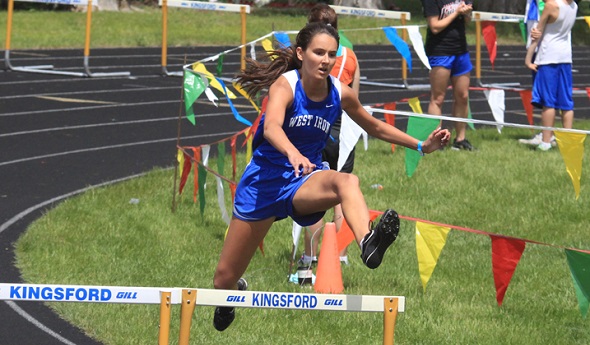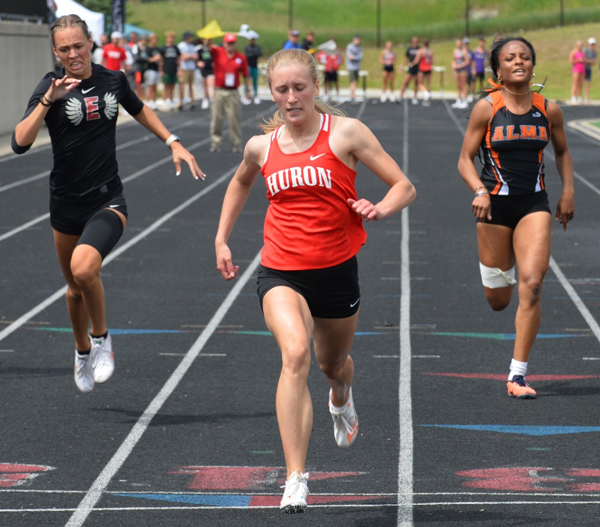
West Iron County Claims 1st MHSAA Crown
By
John Vrancic
Special for MHSAA.com
June 2, 2013
KINGSFORD — It was a historical day for the West Iron County girls at Saturday's Upper Peninsula Track Finals as they were crowned champions for the first time.
The Wykons topped the Division 2 standings with 144 points. Manistique brought home its first runner-up trophy with 99 and Newberry placed third at 84.
"We were down by 12 points at one point during the meet, but I knew we could make up the points," said West Iron coach Kristi Berutti. "The girls were so awesome. They literally did better than they were ranked. This (U.P. title) was our goal from the beginning. We had only two seniors, but they were great leaders. We'll be strong again next year."
West Iron junior Cassilyn Pellizzer won the 300-meter hurdles in a school-record 48.7 seconds, was runner-up in the 100 hurdles (17.41), took third in high jump at 4 feet, 10 inches and helped the winning 1,600 relay.
"I usually get tired on the home stretch and hit the last two hurdles," said Pellizzer, who appeared smooth going over the final two hurdles this time. "I was so nervous before and kind of transferred that energy to the race. The U.P. title was icing on the cake."
 The Wykons, who won three relays, also got firsts from Carli Johnson in the 200 (28.3), Alexis Golfis in long jump (14-3¾) and Megan Miatech in shot put (34-10).
The Wykons, who won three relays, also got firsts from Carli Johnson in the 200 (28.3), Alexis Golfis in long jump (14-3¾) and Megan Miatech in shot put (34-10).
Freshman Holly Blowers took the 800 (2:29.56) for Manistique, which also won the 400 relay.
"We're very happy with being runners-up," said Manistique coach Chris Marana. "This is a big accomplishment for us. Hopefully, this will jumpstart us next year. We're losing some good seniors who will be hard to replace. But we have some good kids coming back. We knew we had to be at our A-plus game to beat West Iron. Our girls definitely competed hard, but West Iron was on top of its game today.”
Newberry freshman Natalie Beaulieu won the 1,600 in a personal-best 5:34.37 and also the 3,200 (12:12.55).
"I'm pretty happy with that," Beaulieu said. "I wanted to try to keep a steady pace. But with this being the U.P. Finals, I found that I went out a little harder. Although, this wasn't anything unexpected. I felt good in the 3,200 relay and 1,600 and was able to get into a rhythm.”
Iron Mountain senior Hailey LaFleur was a double winner, taking the 100 (13.49) and 400 (1:03.02).
PHOTOS: (Top) West Iron County's Cassilyn Pellizzer clears a hurdle en route to winning the 300 race and setting a school record of 48.7 seconds. (Middle) Iron Mountain senior Hailey LaFleur won two championships Saturday. (Photo by Paul Gerard. Click to see more photo coverage from RunMichigan.com.)

Multi-Sprint Champ Racing to Finish Huron Career Ahead of the Rest Again
By
Keith Dunlap
Special for MHSAA.com
May 25, 2023
NEW BOSTON – If there was one thing Elizabeth Anderson took pride in elementary school, it was simply showing that she could outrun everyone in sight.
 In fact, Anderson has an explanation for all the success she had in those playground races.
In fact, Anderson has an explanation for all the success she had in those playground races.
“Dominance when you are in elementary school,” Anderson quipped. “I don’t think I ever had a nickname. I just think everyone knew I was fast.”
Years later, pretty much everyone who follows track & field in the state of Michigan can attest to that.
A senior for New Boston Huron, Anderson has been faster than most other competitors in the state during her three-year high school career (with her freshman season in 2020 canceled due to COVID-19).
Last year, Anderson won titles at the Lower Peninsula Division 2 Finals in the 200-meter (25.07) and 400-meter (56.28) dashes, and was runner-up in the 100-meter dash (12.23).
Often, top sprinters focus on one or two of those three races. But Anderson is certainly a different breed of sprinter because she does all three.
In fact, she holds school records in all three of those events, and if all that weren’t enough, Anderson is a part of all three sprint relay teams.
“It is hard to give her events off,” said New Boston Huron head girls track coach Danielle Lobato.
Despite the different styles the 100, 200 and 400-meter dashes present, Anderson said there usually isn’t much adjusting when she goes from one of those races to another.
 The strategy is simply, “Let’s beat the other girls to the finish line.”
The strategy is simply, “Let’s beat the other girls to the finish line.”
“I don’t really go into each race changing up how I would run,” she said.
While enjoying and succeeding in all three races, Anderson said she actually does have a favorite among them.
“I would say the 400 is probably my favorite,” she said. “Even though it hurts, it’s satisfying to see how much you can get your time down in the 400 compared to any other race.”
Anderson said she started running track in sixth grade, but really got serious about it during the summer after her sophomore season, when she was invited to run for a local club.
Eventually, that led to her competing over the winter in indoor events.
She lived and breathed track so much that last fall, she decided to not run cross country so she could focus on a weightlifting regimen aimed at developing more leg strength.
“Once I started doing summer track, I realized I wanted to be doing this all the time,” she said.
Lobato said oftentimes in practice, Anderson is a de facto coach, given there is no better person she can think of for the younger runners on the team to learn from.
“I can’t always demonstrate these things I’m trying to teach,” she said. “You get to see it in real life (from Anderson), not in a YouTube video.”
After winning the 100, 200 and 400-meter dashes at her Regional meet last week, Anderson has her sights set on achieving the same trifecta of titles at next Saturday’s Finals in Grand Rapids.
Anderson has signed to run track at Michigan State, but has been plenty motivated to keep producing this spring in her final high school season.
“I’m really looking to defend my titles,” she said. “That is what is really motivating me to keep going. I want to keep in shape for the college season. I don’t want to lose any of the progress I have made. Ultimately, I just love running track.”
And since elementary school, Anderson has loved — and succeeded in — outrunning everyone else to the finish line.
“We knew we were getting something special,” Lobato said of when Anderson arrived in high school. “But you never expect this. All that she has accomplished is amazing.”
 Keith Dunlap has served in Detroit-area sports media for more than two decades, including as a sportswriter at the Oakland Press from 2001-16 primarily covering high school sports but also college and professional teams. His bylines also have appeared in USA Today, the Washington Post, the Detroit Free Press, the Houston Chronicle and the Boston Globe. He served as the administrator for the Oakland Activities Association’s website from 2017-2020. Contact him at [email protected] with story ideas for Oakland, Macomb and Wayne counties
Keith Dunlap has served in Detroit-area sports media for more than two decades, including as a sportswriter at the Oakland Press from 2001-16 primarily covering high school sports but also college and professional teams. His bylines also have appeared in USA Today, the Washington Post, the Detroit Free Press, the Houston Chronicle and the Boston Globe. He served as the administrator for the Oakland Activities Association’s website from 2017-2020. Contact him at [email protected] with story ideas for Oakland, Macomb and Wayne counties
PHOTOS (Top) New Boston Huron's Elizabeth Anderson clears the finish line during last season's LPD2 400 race. (Middle) Anderson, middle, outpaces the field to also win the 200. (Click for more from RunMichigan.com.)

